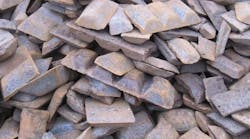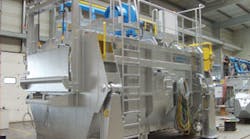The cost-saving potential of aluminum recycling should be tempting to operations like foundries and diecasters that must manage their input costs. In addition to the inevitable expenses of fuel and energy, as well as general operating costs, aluminum is prone to price volatility. High-volume consumers of aluminum must always be watchful for emerging applications, such as the current buzz about aluminum’s use for computer electronics or lighting systems.
On the opposite end of aluminum’s price volatility is the fact that it is so incredibly recyclable. Remelting aluminum consumes just 5% of the energy required to mine bauxite ore and refine it into metal, such that some studies demonstrate that 75% of all the primary aluminum ever produced continues to be in use somewhere.
For the average aluminum foundry or diecaster, these important considerations loom beyond their general concerns, which are focused on the melting, holding, and alloying (dosing) technology they use to produce metal for their finished products. To this audience, a new holding system from the StrikoWestofen Group will be a welcome arrival.
StrikoWestofen — operating in North America as StrikoDynarad — designs melting, holding, and alloying systems for all types of aluminum producers. Multiple variations of the StrikoMelter® melting/holding system are installed for metalcasting, including permanent mold and sand casting foundries and high-pressure diecasting operations. Other installations include numerous holding furnaces and dosing systems for gravity and sand casting and diecasting.
The new H(R)-T is a design that emphasizes the role of recycling in aluminum melting. It’s a flexible concept with a holding capacity of 8,000-20,000 kg (17,600-44,000 lb), but it does not require a shaft system, and it’s available with or without a melting ramp. It is intended for holding aluminum alloys that have been melted in separate reverb or rotary drum furnaces, for adjusting alloy composition, and for controlled casting of liquid metal in launder systems or continuous casting machines.
The first H(R)-T installation is at an aluminum-recycling center in Turkey operated by an Austrian company, KMF Maschinenfabriken (www.kmf.at/), though more installations are under development.
Among other operating divisions, in addition to recycling aluminum KMF manufactures rotary drum furnaces that melt aluminum with a low salt and oxide content. Low temperature carbonization gases released by the melting process are combusted in the rotary drum furnace. The furnace atmosphere is monitored continuously to ensure high yield, so a wide range of materials (aluminum scrap, aluminum chips and dross) can be melted in the rotary drum furnace in a way that is environmentally sound and energy-efficient. This is the system that feeds liquid aluminum to a StrikoWestofen HR-T 10,000/500 furnace for alloying or holding.
In the current installation, the HR-T furnace is outfitted with a melting ramp that improves the flexibility of the operation. The necessary alloys are preheated with a burner mounted above the ramp before they go into the solution. It is also possible to melt up to 500 kg (1,100 lb) per hour of aluminum ingots on the ramp. Porous plugs at the bottom of the holding area ensure the alloys mix well with the molten aluminum; maintain high-temperature in the bath; and aid the degassing process.
In process, once the molten aluminum in the bath is alloyed to specification a hydraulic unit with proportional controls tilts the vessel. The metal can be poured continuously into molds or cast as ingots. KMF is feeding the metal to an ingot-casting conveyor, but the developer indicates that the system also may be used to produce billets or slabs for rolling.
The StrikoWestofen Group sees the new development as an opportunity for metalcasters to broaden the range of production options, to improve their material and operating costs by increasing the capability and flexibility of their installations.









